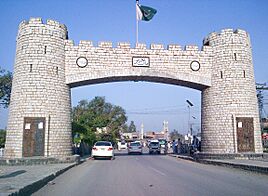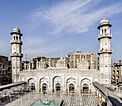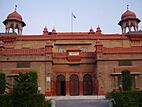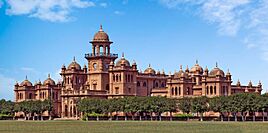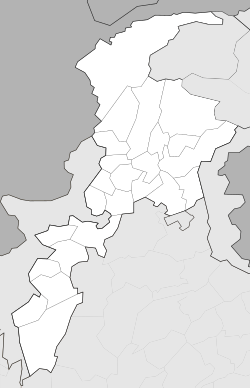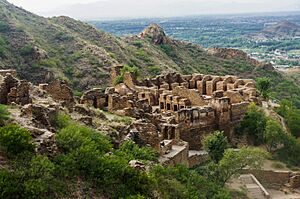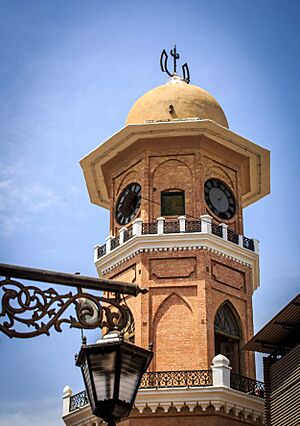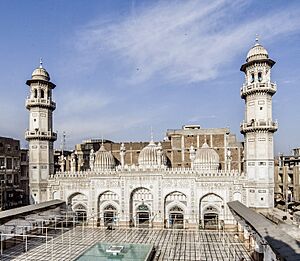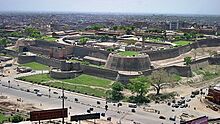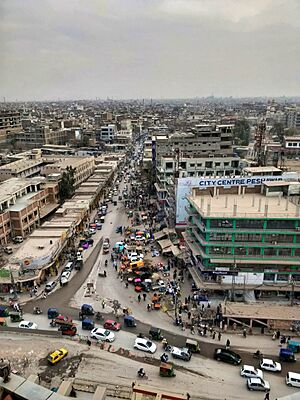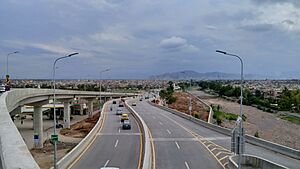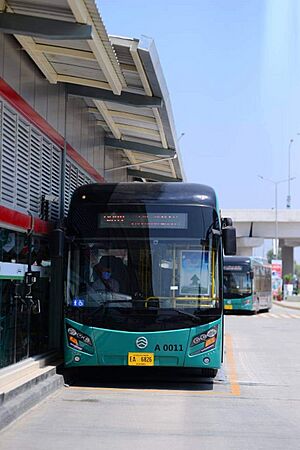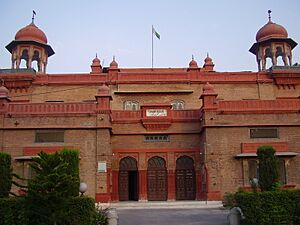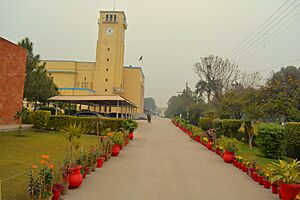Peshawar facts for kids
Quick facts for kids
Peshawar
|
||
|---|---|---|
|
Bab-e-Khyber
Cunningham Clock Tower
Bala Hissar
Mahabat Khan Mosque
Peshawar Museum
Islamia College University
|
||
|
||
| Nickname(s):
City of Flowers
|
||
| Country | ||
| Province | ||
| District | Peshawar District | |
| Union councils | 92 | |
| Government | ||
| • Type | Mayor-council | |
| • Body | District government | |
| Area | ||
| • City | 215 km2 (83 sq mi) | |
| • Metro | 1,257 km2 (485 sq mi) | |
| Elevation | 331 m (1,086 ft) | |
| Highest elevation | 450 m (1,480 ft) | |
| Population
(2023)
|
||
| • City | 1,905,975 | |
| • Rank | 8th, Pakistan | |
| • Density | 8,865/km2 (22,960/sq mi) | |
| Demonym(s) | Peshawari | |
| Time zone | UTC+5:00 (PKT) | |
| Postal code |
25000
|
|
| Area code(s) | 091 (+92) | |
| Languages | Pashto, Hindko, Urdu | |
Peshawar is the capital and largest city of the Khyber Pakhtunkhwa province in Pakistan. It is the 8th most populated city in Pakistan. In 2023, its district had over 4.7 million people. Peshawar is in the northwest of the country. It sits in the Valley of Peshawar. Most people here are Pashtuns. They are the second-largest ethnic group in Pakistan.
Peshawar is in a wide valley east of the famous Khyber Pass. Its recorded history began around 539 BCE. This makes it one of the oldest cities in South Asia. The city was important in the ancient Gandhara kingdom. Peshawar was the capital of the Kushan Empire under Kanishka. It was home to the Kanishka Stupa, one of the tallest buildings in the ancient world.
After the Kushans, many empires ruled Peshawar. These included the Hephthalites and Hindu Shahis. Later, different Muslim empires took over. It was a key trading spot for the Mughal Empire. In 1747, it became part of the Durrani Empire. It served as their winter capital. The Sikh Empire captured the city in 1823. Finally, in 1849, the British East India Company took control. Peshawar stayed under British Raj until Pakistan became independent in 1947.
Contents
- What's in a Name? The Story of Peshawar
- Journey Through Time: Peshawar's History
- Exploring Peshawar's Landscape
- People of Peshawar: Population and Languages
- Peshawar's Economy: Trade and Growth
- Getting Around: Transportation in Peshawar
- How Peshawar is Governed
- Peshawar's Culture
- Learning in Peshawar: Education Hub
- Famous Places: Landmarks in Peshawar
- Sports in Peshawar
- Sister Cities
- Images for kids
- See also
What's in a Name? The Story of Peshawar
The name "Peshawar" probably comes from an old Sanskrit word, "Purushapura." This means "City of Men" or "City of Purusha." Mughal Emperor Akbar gave it this name. He changed its older name, Parashawar, which he did not understand. Some people think the city was named after a Hindu ruler called Purush. The word pur means "city" in Sanskrit.
Another idea is that the name means "City of Flowers," or Poshapura. This name is in an old writing. It might refer to Peshawar. Ancient Chinese travelers also wrote about the city. They called it names like Po-la-sha-pu-lo or Fou-lou-sha. These were their versions of Purushapura.
By the mid-10th century, Arab historians called the city Parashāwar. Later, it became known as Peshāwar during Emperor Akbar's time. Some believe the current name comes from a Persian word. It means "frontier town" or "forward city." This is because Peshawar was often the first big city people reached. They arrived after crossing the Khyber Pass into the Indian subcontinent.
Journey Through Time: Peshawar's History
Ancient Beginnings: Early History

Peshawar and the Gandhara region are mentioned in old texts. The city was founded as Puruṣapura around 100 CE. It was on the Gandhara Plains. It was near the old Gandharan capital of Pushkalavati. This is close to today's Charsadda.
Greek and Mauryan Rule
In 327–26 BCE, Alexander the Great conquered the Valley of Peshawar. After him, the area came under the Seleucid Empire. Later, in 303 BCE, it became part of the Mauryan Empire. Around 300 BCE, a Greek historian wrote about Purushapura. He noted it was the western end of a major road. This road connected it to the Mauryan capital.
As the Mauryan Empire became weaker, the Greco-Bactrian Kingdom took over Peshawar. This was around 190 BCE. Then, Gondophares, who started the Indo-Parthian Kingdom, captured the city. He built the nearby Takht-i-Bahi monastery in 46 CE. It became a major center for Buddhist learning.
Kushan Empire: A Golden Age
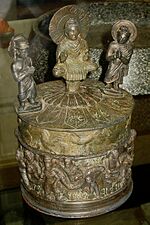
In the first century CE, Purushapura came under the Kushan Empire. It became their main winter capital. The city was very large. It had an estimated 120,000 people. This made it one of the world's biggest cities then. The Kushan emperor, Kanishka, was a strong Buddhist. He built the grand Kanishka Mahavihara monastery. After he died, the amazing Kanishka stupa was built in Peshawar. It held Buddhist relics. This golden age ended around 232 CE.
Around 260 CE, the Sasanid Empire attacked Peshawar. Many Buddhist sites were damaged. The Kushans became less powerful. Later, the Central Asian Kidarites captured the city in the early 400s CE.
White Huns and Decline
The White Huns destroyed ancient Peshawar in the 460s CE. They ruined many monasteries in the Gandhara region. The Kanishka stupa was rebuilt with a tall wooden structure. In the 400s CE, the Chinese Buddhist traveler Faxian visited. He described it as "the highest of all the towers" in the world.
By 630 CE, another Chinese monk, Xuanzang, visited Peshawar. He sadly noted that the city and its great Buddhist monuments were in ruins. Only about 1,000 families lived in a small part of the once-grand capital.
Medieval Times: New Rulers and Islam's Arrival
By the mid-7th century, the Hindu Shahis of Kabul took control of Peshawar. Islam is believed to have arrived in Peshawar in the late 7th century. The Dilazak Pashtuns were the first Pashtun tribe to settle in the Valley of Peshawar.
In 986–87 CE, Muslim armies first reached Peshawar. On November 28, 1001, Mahmud Ghazni defeated the Hindu Shahis. This happened at the Battle of Peshawar. This started the rule of the Ghaznavid Empire in the region. Peshawar became an important stop between Afghanistan and Lahore.
In 1179–80, Muhammad Ghori captured Peshawar. However, the city was later destroyed by the Mongols in the early 1200s. Peshawar became an important regional center. This was under the Lodi dynasty of the Delhi Sultanate. Many Pashtun tribes settled around Peshawar in the late 15th and 16th centuries.
Early Modern History: Mughal and Afghan Empires
Mughal Empire: Trade and Rebellions
Peshawar remained a key center for trade. It connected India and Central Asia. In July 1526, Emperor Babur captured Peshawar. He rebuilt the city's fort. He used Peshawar as a base for his trips.
Under Babur's son, Humayun, the Pashtun king Sher Shah Suri challenged Mughal rule. Sher Shah Suri began building the famous Grand Trunk Road in the 16th century. Peshawar was an important trading point on this road. During Akbar's rule, the city's name changed from Begram to Peshawar. In 1586, Pashtuns rebelled against Mughal rule. They even surrounded the city.
Peshawar also had its own Shalimar Gardens during Shah Jahan's time. They no longer exist. In the 17th century, the Mughal governor of Kabul, Mohabbat Khan, used Peshawar as his winter capital. He built the famous Mohabbat Khan Mosque in 1630.

Pashtun tribes kept fighting Mughal rule. After Emperor Aurangzeb died in 1707, Mughal power weakened. In 1738, Nader Shah's Persian armies captured Peshawar from the Mughals.
Durrani Empire: Afghan Capital
In 1747, Ahmad Shah Durrani started the Afghan Durrani Empire. He took Peshawar. His son, Timur Shah, made Peshawar the winter capital. This continued until the Sikh invasion. Peshawar's Bala Hissar Fort was where Afghan kings stayed in winter. The city was also known for trading dried fruit.
Sikh Empire: Changes and Challenges
Ranjit Singh of the Sikh Empire invaded Peshawar in 1818. After a big win in 1823, he captured Peshawar again. By 1830, Peshawar's economy had gotten worse. This was due to fighting and high taxes from Sikh forces. The city's palace and farms were damaged.
The Sikh Empire officially took over Peshawar in 1834. Sikh settlers from Punjab moved to the city. The Sikhs also rebuilt the Bala Hissar fort.
British Raj: Modernization and Frontier Headquarters
After defeating the Sikhs, the British East India Company captured Peshawar in 1849. The British brought peace. They made Peshawar their main base for the frontier. They built the large Peshawar Cantonment in 1868. They also connected the city by railway. They fixed up the Mohabbat Khan mosque.
The British built the Cunningham clock tower in 1900. They built the Victoria Hall (now Peshawar Museum) in 1906. They also started Western education. They opened Edwardes College in 1901 and Islamia College in 1913. In 1901, Peshawar became the capital of the new North-West Frontier Province.
In 1910, there were some problems between different groups in the old city. Even with leaders trying to help, fights happened. This caused damage and injuries.
Peshawar became a center for thinkers during the British era. It was also home to a peaceful resistance movement. This was led by Ghaffar Khan. In 1930, his followers protested against colonial laws. Many were killed when British Indian Army soldiers shot at them.
Modern Era: Pakistan and Recent Challenges
In 1947, Peshawar became part of the new country of Pakistan. It grew as a cultural center in the northwest. The University of Peshawar was started in 1950. Until the mid-1950s, Peshawar had a city wall with sixteen gates.
From the 1960s to the late 1970s, Peshawar was a major stop on the famous Hippie trail. During the Soviet–Afghan War in the 1980s, Peshawar became a key center for Afghan refugees. Many refugees arrived. This put a strain on the city's resources. It also changed its population.
Like other parts of northwest Pakistan, Peshawar has faced challenges. There have been attacks on cultural sites and public places. However, efforts to improve safety have greatly reduced such events. The city continues to work for peace and stability.
Exploring Peshawar's Landscape
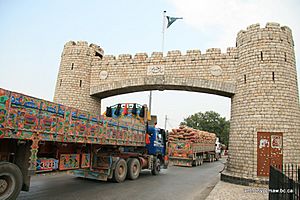
City Location and Features

Peshawar is in the wide Valley of Peshawar. Mountains surround the valley on three sides. The fourth side opens to the Punjab plains. The city itself is on the flat land of the valley. This area is known as the Gandhara Plains. It serves as a gateway to the famous Khyber Pass.
Peshawar's Climate
Peshawar has a hot, semi-arid climate. This means it has very hot and long summers. Winters are short, mild to cool. Winter usually starts in November and ends in late March. Summer months are from mid-May to mid-September. The average high temperature in summer is over 40°C (104°F).
Peshawar does not have a typical monsoon season. But it does get rain in both winter and summer. Winter rainfall is usually higher. The hottest temperature ever recorded was 50°C (122°F) in June 1995. The lowest was -3.9°C (25°F) in January 1970.
A 2024 report said Peshawar is one of the world's most polluted cities.
City's Appearance: Old and New
Peshawar's city design is like other old cities in South Asia. Examples are Lahore and Delhi. These cities were often built near a big river. They had an old walled city with a royal fort.
Historically, old Peshawar was a very protected city. It had high walls. Today, only parts of these walls remain. Many old houses and mansions are still important buildings. They are often built with unbaked bricks and wood. They have wooden doors and balconies. You can see many examples of this old style in areas like Sethi Mohallah.
The old city, or inner-Peshawar, still has many historic places and markets. These include the Mohabbat Khan Mosque, Chowk Yadgar, and the famous Qissa Khawani Bazaar. Because of modern growth, the old walled city needs urgent care and protection. The government plans to restore the old city gates. These were once the main entry points.
People of Peshawar: Population and Languages
City Population
| Historical population | ||
|---|---|---|
| Year | Pop. | ±% |
| 1881 | 79,982 | — |
| 1891 | 84,191 | +5.3% |
| 1901 | 95,147 | +13.0% |
| 1911 | 97,935 | +2.9% |
| 1921 | 104,452 | +6.7% |
| 1931 | 121,866 | +16.7% |
| 1941 | 173,420 | +42.3% |
| 1951 | 151,776 | −12.5% |
| 1961 | 218,000 | +43.6% |
| 1972 | 273,000 | +25.2% |
| 1981 | 555,000 | +103.3% |
| 1998 | 982,816 | +77.1% |
| 2017 | 1,964,102 | +99.8% |
| 2023 | 1,905,975 | −3.0% |
Macrotrends (2021)Census of India (1921) |
||
According to the 2023 census, Peshawar is the 8th largest city in Pakistan. It is also the largest city in Khyber Pakhtunkhwa province. It has a population of 1,905,975 people. Its population is five times larger than the next biggest city in the province.
Afghan Refugees in Peshawar
Peshawar has welcomed Afghan refugees since the Afghan civil war began in 1978. The number of refugees grew a lot after the Soviet invasion of Afghanistan in 1979. By 1980, about 100,000 refugees came into the province each month. This large number of refugees put a strain on Peshawar's resources. It also changed the city's population.
Many Afghan musicians and artists came to Peshawar. This made the city a center for Afghan culture and Pashto literature. Some Afghan refugees have also started successful businesses. They help Peshawar's economy. In recent years, Peshawar district has hosted many Afghan refugees in Pakistan.
Languages Spoken in Peshawar
Languages by number of speakers in the Peshawar district, 2011 Pashto (90.17%) Hindko (5.33%) Urdu (1.96%) Punjabi (1.08%) Others (1.46%)
Languages by number of speakers in the Peshawar district, 1881 Pashto (77.2%) Punjabic (18.9%) Hindustani (2.1%) English (0.7%) Others (1.1%)
The main language spoken in Peshawar is Pashto. Hindko is a minority language. It is mostly spoken in Peshawar's old city. While English is used in schools, Urdu (Pakistan's national language) is understood throughout the city.
Religions in Peshawar
Peshawar is mostly Muslim. About 98.5% of the people were Muslim in the 1998 census. Christians are the second largest religious group. There are also members of the Ahmadiyya Community, Hindus, and Sikhs in the city. Most Hindu and Sikh people moved to India after the Partition of British India in 1947.
Even though many Sikhs left after Partition, the Sikh community in Peshawar has grown. This is because Sikhs from other areas have arrived. In 2008, Peshawar had the largest Sikh population in Pakistan. Sikhs in Peshawar often see themselves as Pashtuns. They also speak Pashto.
| Religious group |
1868 | 1881 | 1891 | 1901 | 1911 | 1921 | 1931 | 1941 | 2017 | 2023 | ||||||||||
|---|---|---|---|---|---|---|---|---|---|---|---|---|---|---|---|---|---|---|---|---|
| Pop. | % | Pop. | % | Pop. | % | Pop. | % | Pop. | % | Pop. | % | Pop. | % | Pop. | % | Pop. | % | Pop. | % | |
| Islam |
54,977 | 67.65% | 57,378 | 71.74% | 60,269 | 71.59% | 68,352 | 71.84% | 73,198 | 74.74% | 73,882 | 70.75% | 86,369 | 70.87% | 122,972 | 70.91% | 1,942,636 | 98.62% | 1,872,113 | 98.56% |
| Hinduism |
21,802 | 26.83% | 18,105 | 22.64% | 15,501 | 18.41% | 18,552 | 19.5% | 16,328 | 16.67% | 21,001 | 20.11% | 21,973 | 18.03% | 31,630 | 18.24% | 1,720 | 0.09% | 1,726 | 0.09% |
| Christianity |
3,379 | 4.16% | N/A | N/A | 3,629 | 4.31% | 3,063 | 3.22% | 3,132 | 3.2% | 3,414 | 3.27% | 4,854 | 3.98% | 2,586 | 1.49% | 22,032 | 1.12% | 23,638 | 1.24% |
| Sikhism |
994 | 1.22% | 1,465 | 1.83% | 4,755 | 5.65% | 5,144 | 5.41% | 5,026 | 5.13% | 6,152 | 5.89% | 8,630 | 7.08% | 14,245 | 8.21% | N/A | N/A | 1,441 | 0.08% |
| Jainism |
N/A | N/A | 3 | 0% | 0 | 0% | 0 | 0% | 3 | 0% | 3 | 0% | N/A | N/A | N/A | N/A | N/A | N/A | ||
| Zoroastrianism |
N/A | N/A | N/A | N/A | 33 | 0.04% | 34 | 0.04% | 47 | 0.05% | 20 | 0.02% | 29 | 0.02% | 14 | 0.01% | N/A | N/A | 0 | 0% |
| Judaism |
N/A | N/A | N/A | N/A | 4 | 0% | N/A | N/A | 1 | 0% | 0 | 0% | 11 | 0.01% | 70 | 0.04% | N/A | N/A | N/A | N/A |
| Buddhism |
N/A | N/A | N/A | N/A | 0 | 0% | 0 | 0% | 0 | 0% | 0 | 0% | N/A | N/A | N/A | N/A | N/A | N/A | ||
| Ahmadiyya |
N/A | N/A | N/A | N/A | N/A | N/A | N/A | N/A | N/A | N/A | N/A | N/A | N/A | N/A | N/A | N/A | 924 | 0.05% | 166 | 0.01% |
| Others | 112 | 0.14% | 3,031 | 3.79% | 0 | 0% | 2 | 0% | 0 | 0% | 0 | 0% | 0 | 0% | 1,903 | 1.1% | 2,511 | 0.13% | 476 | 0.03% |
| Total population | 81,264 | 100% | 79,982 | 100% | 84,191 | 100% | 95,147 | 100% | 97,935 | 100% | 104,432 | 100% | 121,866 | 100% | 173,420 | 100% | 1,969,823 | 100% | 1,899,560 | 100% |
Peshawar's Economy: Trade and Growth
Peshawar's economy has always been important. This is because of its location. It sits at the entrance to the Khyber Pass. This old route was used for most trade. It connected Central Asia and the Indian subcontinent. In the mid-20th century, tourism also helped Peshawar's economy. It was a key stop on the Hippie trail.
In 2015, Peshawar's estimated monthly income per person was about ₨55,246. This was lower than in cities like Islamabad or Karachi. The area around Khyber Pakhtunkhwa is also less wealthy.
The World Bank noted in 2014 that Peshawar was leading a movement. It was creating chances for new businesses. It also helped with freelance jobs and technology. The city hosts the annual Digital Youth Summit. This event connects young people to digital economy jobs.
Industries and Jobs
Peshawar has industrial zones. These include the Industrial Estate on Jamrud Road. There is also the Hayatabad Industrial Estate. These areas have furniture, marble, and food processing businesses. As part of the China Pakistan Economic Corridor, new special economic zones are being set up. These zones aim to create many jobs. They will have good facilities like roads, electricity, and gas.
In 2012, only 12% of Peshawar's people had formal jobs. Many people, especially Afghan refugees, worked for daily wages. By 2016, Pakistan started a plan to help Afghan refugees return to Afghanistan.
Wages for unskilled workers in Peshawar grew well. This was between 2002 and 2008. However, after 2007, growth slowed. This was due to security challenges.
Economic Challenges and Solutions
Peshawar's economy has been affected by political problems since 1979. This was mainly due to the War in Afghanistan and many refugees. Safety issues also impacted the city's economy. However, after Operation Zarb-e-Azb started in 2014, the safety situation greatly improved.
The city's economy also faces problems. These include poor roads and not enough electricity and natural gas. The $54 billion China Pakistan Economic Corridor project aims to fix electricity shortages. It also wants to improve transportation. This includes upgrading railway lines between Peshawar and Karachi.
For many years, Peshawar had messy public transportation. This also hurt the city's economy. To fix this, the government started a new bus service. It is called BRT Peshawar. This modern system covers the whole city. It is one of Pakistan's most advanced BRT systems.
Getting Around: Transportation in Peshawar
Road Network
Peshawar's main road for travel is the historic Grand Trunk Road. This road connects Peshawar to Islamabad and Lahore. The M-1 Motorway runs next to it. It links Peshawar to Islamabad and other big cities. These include Charsadda and Mardan. The M-1 then connects to the M-2 Motorway for Lahore.
The Grand Trunk Road also leads to the Afghan border. This is through the Khyber Pass. From there, you can travel to Kabul and Central Asia. The Peshawar Ring Road is being built. It will help reduce traffic in the city center.
The Karakoram Highway connects the Peshawar region to western China. It offers another route to Central Asia. The Indus Highway goes south from Peshawar to Karachi. The Kohat Tunnel helps connect Peshawar to the city of Kohat on this highway.
Rail Travel
Peshawar Cantonment railway station is the end point for Pakistan's main railway line. This is the Main Line-1. This line connects Peshawar to the port city of Karachi. Trains like the Awam Express and Khyber Mail use this route.
The Main Line-1 railway track is being improved. This will let trains travel much faster. Peshawar was also once the start of the Khyber train safari. This was a tourist train that went to Landi Kotal. This service stopped due to safety worries.
Air Travel
Peshawar is served by the Bacha Khan International Airport. It is in the Peshawar Cantonment. This airport handles many passengers. Most are international travelers. It offers direct flights within Pakistan. It also flies to countries like Qatar, Saudi Arabia, and the United Arab Emirates.
Public Transit
BRT Peshawar is a modern rapid bus service. It started in August 2020. It has 30 stations and 244 buses. It covers areas from Chamkani to Karkhano Market. BRT Peshawar has replaced the city's old transport system. It includes raised sections and underpasses. It also has feeder lines to connect more areas.
Intercity Buses
Peshawar has many private buses and vans. They are often called "flying coaches." These offer frequent connections throughout Khyber Pakhtunkhwa. They also connect to all major cities in Pakistan. The city's Daewoo Express bus terminal is a central point for many transport companies.
How Peshawar is Governed
City Politics
Peshawar has always been an important political center. It is the capital of Khyber Pakhtunkhwa province. The city and province have usually supported the Awami National Party. This is a secular and moderate-nationalist party. The Pakistan Peoples Party also had strong support. This was due to its socialist ideas.
Even though it's a center for left-leaning politics, Peshawar is generally known for its social conservatism. Sunni Muslims in the city are often socially conservative. The Shia population is considered more socially liberal.
In 2002, a religious group, the Muttahida Majlis-e-Amal, was elected to power. They introduced some social rules. However, Islamic law was not fully put in place. For example, public musical shows were limited. But this led to a lively underground music scene. In 2005, they passed a law. It led to the removal of public ads showing women.
In 2008, the secular Awami National Party won the elections. The socially conservative laws were removed. In 2013, the Pakistan Tehreek-e-Insaf party was elected. They focused on fighting corruption.
City Services
As of 2015, most homes in Peshawar (86%) have access to city water pipes. However, 39% of homes still buy water from private companies. About 42% of Peshawar homes are connected to the city's sewage system.
Peshawar's Culture
Music Scene
After the 2002 government limited public music, a strong underground music scene grew in Peshawar. When safety problems increased around 2007–2008, attackers targeted music and video shops. Many closed. Some Pashto music artists were also attacked.
However, by 2016, musicians started coming back to the city. This was as the safety situation got better. The provincial government has even announced money to help musicians. They also have a fund to "bring back the rich cultural heritage of the province."
Museums to Explore
The Peshawar Museum was started in 1907. Its building mixes British, South Asian, Hindu, Buddhist, and Mughal Islamic styles. The museum has almost 14,000 items. It is especially famous for its collection of Greco-Buddhist art. The museum's ancient collection includes pieces from the Gandharan, Kushan, Parthian, and Indo-Scythian times.
Learning in Peshawar: Education Hub
Peshawar has many schools, colleges, and universities. In 2013, about 21.6% of children aged 5 to 9 were not in school. Also, 16.6% of children aged 10 to 14 were out of school.
Peshawar now has universities for all major subjects. These include humanities, sciences, engineering, medicine, agriculture, and management. The first public university, University of Peshawar (UOP), was started in 1950. The University of Engineering and Technology, Peshawar opened in 1980. The Agriculture University Peshawar opened in 1981.
The first private university, CECOS University of IT and Emerging Sciences, was founded in 1986. The Institute of Management Sciences started in 1995.
There are currently 9 medical colleges in Peshawar. Two are public, and seven are private. The first medical college, Khyber Medical College, was started in 1954. The Khyber Medical University and a women-only medical college, Khyber Girls Medical College, were started in 2007.
In the 21st century, many new private universities opened in Peshawar. These include Qurtuba University, Sarhad University of Science and IT, Fast University, Peshawar Campus, and City University of Science and IT. All were started in 2001. Gandhara University opened in 2002. Abasyn University opened in 2007.
Shaheed Benazir Bhutto Women University, Peshawar's first women's university, started in 2009. The private IQRA National University was started in 2012.
Besides universities, Peshawar has many high-quality colleges for further education. The most famous are Edwardes College, founded in 1900, and Islamia College Peshawar, started in 1913. Islamia College became Islamia College University in 2008.
Here are some of the public and private universities and colleges in Peshawar:
- Abasyn University (Abasyn University, Peshawar)
- Agricultural University (Peshawar)
- CECOS University of IT and Emerging Sciences
- City University of Science and Information Technology, Peshawar
- Edwardes College
- Forward Degree College
- Frontier Women University
- Gandhara University
- Government College Hayatabad Peshawar
- Government College Peshawar
- Government Girls Degree College, Peshawar
- Government Superior Science College Peshawar
- IMSciences (Institute of Management Sciences)
- Iqra National University, Peshawar (formerly Peshawar Campus of Iqra University Karachi)
- Islamia College University
- Jinnah College for Women
- Jinnah Medical College
- Khyber Girls Medical College
- Khyber Medical College
- Khyber Medical University
- National University of Computer and Emerging Sciences, Peshawar Campus (NU-FAST)
- Pakistan Forest Institute, Peshawar
- Peshawar Medical College
- Kabir Medical College
- Sardar Begum Dental College
- Preston University
- Qurtuba University (Qurtuba University of Science & Information Technology)
- Rehman Medical College
- Sarhad University of Science and Information Technology
- Shaheed Benazir Bhutto Women University
- University of Agriculture, Peshawar
- University of Engineering and Technology, Peshawar
- University of Peshawar
The Pakistani military also runs the Army Public School Peshawar.
Famous Places: Landmarks in Peshawar
Here are some important landmarks you can find in Peshawar today:
- General Sites
- Governor's House
- Peshawar Garrison Club – on Sir Syed Road near the Mall
- Kotla Mohsin Khan – home of Mazullah Khan, a 17th-century Pashtu poet
- Qissa Khwani Bazaar – a famous storytelling market
- Kapoor Haveli – former home of the famous actor Prithviraj Kapoor
- Forts
- Bala Hisar Fort
- Colonial Monuments
- Chowk Yadgar (formerly the "Hastings Memorial")
- Cunningham clock tower – built in 1900 and known as "Ghanta Ghar"
- Buddhist Sites
- Gorkhatri – an ancient site. People believe Buddha's alms bowl was kept here.
- Pashto Academy – the site of an ancient Buddhist university
- Shahji ki Dheri – the site of the famous Kanishka stupa
- Hindu Sites
- Sikh Sites
- Sikh Gurudwara at Jogan Shah
- Parks and Gardens
- Army Stadium
- Wazir Bagh – created in 1802
- Ali Mardan Khan Gardens (also known as Khalid bin Waleed Park)
- Shahi Bagh – a small part of it is now Arbab Niaz Stadium
- Jinnah Park – a park on GT Road opposite Balahisar fort
- Tatara Park – a park in Hayatabad
- Bagh e Naran – a large park in Hayatabad that also has a Zoo.
- Mosques
- Mohabbat Khan Mosque
- Qasim Ali Khan Mosque
- Museums
- Peshawar Museum
- Zoo
- Peshawar Zoo
Sports in Peshawar
Peshawar has many sports facilities. The most well-known are Arbab Niaz Stadium and Hayatabad Cricket Stadium. These are international cricket grounds. Qayyum Stadium is a multi-sport facility in Peshawar Cantonment.
Cricket is the most popular sport in Peshawar. Arbab Niaz Stadium is the main ground. It has a Cricket Academy. There's also a smaller ground, Peshawar Gymkhana Ground. It is popular for club cricket. The oldest international cricket ground in Peshawar is Peshawar Club Ground. It hosted the first test match between Pakistan and India in 1955. The Peshawar Zalmi team represents the city in the Pakistan Super League.
The first sports complex, Qayyum Stadium, was built in Peshawar in 1975. Hayatabad Sports Complex was built in the early 1990s. Both are multi-sport complexes. They have facilities for football, field hockey, squash, swimming, and more. Qayyum Stadium hosted a Barcelona Olympics Qualifier Football match in 1991. Hockey and squash are also popular in Peshawar.
- Professional sports teams from Peshawar
| Club | League | Sport | Venue | Established |
|---|---|---|---|---|
| Peshawar Zalmi | Pakistan Super League | Cricket | Arbab Niaz Stadium | 2015 |
| Peshawar Panthers | National T20 League/National One-day Championship | Cricket | Arbab Niaz Stadium | 2004 |
| Peshawar Haiders | Super Kabaddi League | Kabaddi | Tehmas Khan Stadium | 2018 |
| Tribe F.C. Peshawar | Geo Super Football League | Football | Qayyum Stadium | 2007 |
Sister Cities
Peshawar is connected with these cities:
Images for kids
See also
 In Spanish: Peshawar para niños
In Spanish: Peshawar para niños
- Peshawari chappal
- Peshawari turban
- Karkhano
- Kushan Empire
- Kanishka
- Bacha Khan
- Khudai Khidmatgar
- 2014 Peshawar school attack
- 2020 Peshawar school bombing
- Chapli Kabab


